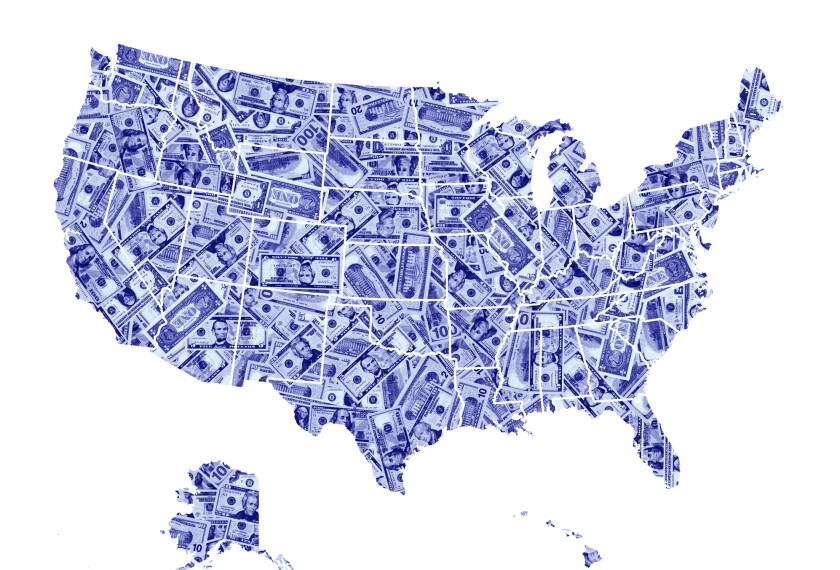Corrected: An earlier version of a graphic showing the percentage of school bonds passed from 2015-2022 contained the wrong figures. It has been corrected.
Local taxpayers nationwide last year voted to borrow a dramatically larger sum of money than in recent years to fund school facilities upgrades, technology purchases, and other budget priorities.
Still, roughly one in four school district bond elections failed—a slightly larger percentage than in the preceding six years.
These data come from the SchoolBondFinder tool developed by the Amos Group, a firm that sells school finance data to companies looking to contract with districts.
The tool shows districts proposed 2,146 bond issues worth a total of $123 billion in 2022. Voters approved roughly 1,644, totaling $96 billion.
Districts asked voters to approve a lot more spending last year than in any previous year since the 2014 inception of SchoolBondFinder. The proposed bond issues were worth more than double the sum from 2021. The $96 billion that voters approved was nearly 90 percent more than the $51 billion voters approved in 2021. Voters OK’d $62 billion in borrowing in 2020, and $48 billion in 2019.
The number of proposed bond issues was also higher in 2022 than in each of the previous three years.
Several factors contributed to the burst in proposed spending, said Rachel Wisnefski, the Amos Group’s chief revenue officer. Bonds tend to be more common on ballots in even years, when higher-profile elections are also taking place. Districts are also looking ahead to a future without federal COVID relief funds that run out next year, which means they’ll have to tap into other sources.
And many districts have become more acutely aware of defects in their facilities, thanks to the growing scrutiny on indoor air quality brought on by the pandemic.
“It pretty much was a perfect storm,” Wisnefski said.
Ballotpedia tracks school bond elections in the nation’s 100 largest districts. That cohort proposed 141 bond issues in 2022, compared with 201 in 2020, the previous even year.
The fact that larger districts didn’t register an uptick in bond elections means smaller districts contributed more to the overall leap in bond elections in 2022, said Samuel Wonacott, a staff writer for Ballotpedia.
How districts use bonds—with voters’ input
Most states require school districts to seek voter approval before issuing bonds to pay for lengthy and expensive facilities projects like HVAC repairs and roof replacements, as well as for technology tools, measures to improve compliance with the Americans With Disabilities Act, and heightened security measures.
Local taxpayers in recent years have been overwhelmingly supportive of schools’ efforts to finance big investments via debt they’ll pay back with interest over a period of years. Only one state—Montana—saw districts win fewer than 40 percent of bond elections in 2022.
Between 2015 and 2022, voters approved 79 percent of bond issues and rejected 21 percent.
Bonds can be helpful for districts to take care of costly projects without imposing severe tax hikes or relying on volatile state aid.
They also, however, leave districts at the mercy of voters, including those without children in the local school system. Districts where bond elections fail often have to defer maintenance or cut other programs to fuel needed investments.
Some states require a simple majority of voters to support the initiative. Others require more robust support.
In Idaho, for instance, bond elections that might succeed in another state fail if they don’t reach a 60 percent threshold of support. Since 2006 in Idaho, districts have surpassed that threshold in 44 percent of bond elections, compared with the 62 percent of elections they would have won if the vote required a simple majority, ProPublica and the Idaho Statesman reported earlier this year.
The SchoolBondFinder site includes data stretching back to the 1960s—but prior to 2014, the company’s findings are likely far less comprehensive than for recent years when the company was actively searching for bond elections as they happened, Wisnefski said.
Since 2014, the Amos Group’s staff and artificial-intelligence assistants have meticulously combed through local media reports, district websites, request for proposal documents, and other publicly available documentation to assemble a near-comprehensive database of school bond elections in every state.
“I would never say that we get 100 percent of the school districts but we darn well get close to 99 percent,” Wisnefski said.
2022 was a banner year for bond elections
Voters approved bonds at a higher volume last year than in recent years. But the percentage of failed bond elections last year—24 percent—slightly outpaced that of the preceding years.
In 2021, voters approved 81 percent of districts’ proposed bond issues. Every year since 2016, the percentage has been higher than it was in 2022.
So far this year, districts have proposed $74 billion in bond issues, many of which will be voted on later this year. It remains to be seen whether last year’s borrowed amount and lower passage rates were anomalies.






